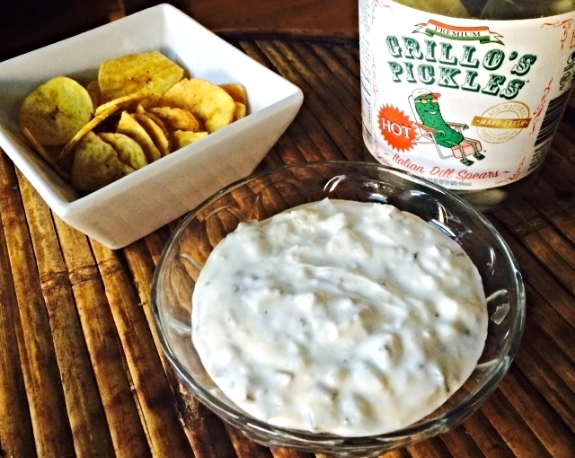Guide to Buy: Yogurt
So many times I get these types of questions:
"What do you think about yogurt?"
"What kinds of protein powder should I use?"
"Should I use almond butter, or peanut butter?"
While I always encourage people to look at the BIG picture, having worked in the food and grocery industry for a few years, I feel confident in saying not all products are created equally. So this week intern, Alix put together the first Guide to Buy featuring Yogurt! Make sure to scroll on down to see our list of guidelines along with our top 4 picks for yogurts, plus, grab Alix's recipe for Pickle Dip! Let's start with a little Q/A...
Yogurt FAQs
What is “Greek” yogurt?
Greek yogurt differs from regular yogurt in that before greek yogurt is packaged for the shelf, the yogurt it strained to remove the liquid remaining after the milk curdles (this is called whey). The by-product is a yogurt that is more solidified, and has less sugar and carbohydrates. However, the FDA still does not have specific regulations for greek yogurt. Companies can add extra ingredients and include additives of their choice and still call their product “greek yogurt.” Any “whey concentrates” or added thickeners like cornstarch are added into the yogurt after it’s strained. Greek yogurt is always strained to achieve its consistency, and sometimes yogurt with added ingredients skips the straining process, which means it isn’t real greek yogurt.
Is Greek yogurt is better for you?
Greek yogurt, as compared to a regular yogurt or a whipped, light yogurt, is thicker and more nutrient dense. Because of this, I recommend plain greek yogurt as your first choice in yogurt, simply because if you choose the right kind, it’s more natural and pure. You have less added sugars and preservatives to worry about, and 8 oz of greek yogurt provides you with a hefty portion of your protein needs for the day.
What is grass milk and why is it in yogurt?
No, grass milk is not what happens when you juice grass (I’ve heard it all). Grass milk is a non-homogenized milk that comes from cows that are 100% grass-fed, as opposed to supplemented for growth with soybeans and grains. If you think about it, the more processed a cow's diet, the more processed the milk product. Since cow's thrive on a grass-fed diet, both the milk and meat of grass-fed cows have been shown to have healthier nutrient profiles and contain a higher proportion of healthy (Omega-3) fats.
What yogurts are made without bovine growth hormone?
Bovine growth hormone (usually seen as rBGH) is a hormone given to cows in order for them to produce more milk. And guess what? The hormone also get’s secreted in the cow’s milk. And then we drink it. Fun, right? No.
Luckily, there is a movement today to encourage leader yogurt retailers to definitively stop using bovine growth hormone in their products. Most organic companies, state that they do not use bovine growth hormone (like all of the recommendations below).. Chobani is the leading greek yogurt provider right now, and they have not yet confirmed or denied their use of the hormone. Bottom line: our hormones are already out-of-wack enough as it is - don’t make it worse. Stick with the hormone-free yogurts!
What to consider when choosing a yogurt:
- Probiotic Content: We know and have heard that yogurt gets its characteristics from the live bacteria inside the container. We have heard that probiotics “regulate your system” and do a lot for your body when it comes to maintaining health. The truth is, not all yogurts have beneficial bacteria, and the farther they stray away from this key component, the less we should consider them REAL yogurt that has the actual benefits that we hear so much about. When looking to assess probiotic contributions, look at the label for the following two bacteria: Lactobacillus bulgaricus and Streptococcus thermophilus. These are the only two bacteria you need to ferment milk, which is ALL yogurt is! A laundry list of ingredients will contain additives and extra sugary substances (note: be on alert for anything that ends in “ose”).
- Check the Ingredients: Look for yogurts that have no added sugar. That means looking at the ingredient list (as milk has naturally occurring sugars that you can’t get rid of). Then, check the nutrition facts label and check out the protein content. If you’re using yogurt as a meal replacement (on-the-go breakfast or lunch) the higher protein content will keep you fuller, longer.
- Expiration Date: This may seem like a no brainer, but this recommendation is NOT what you think! In order to keep from going sour, the yogurt that is shelf stable for long periods of time has been properly heat treated. This means that there are no viable cultures in the yogurt at this point in time. There might have been prior to heat treating, but in order to reap any probiotic benefits, keep with yogurt that expire sooner rather than later (seriously).
- DIY “Fruit Yogurt.” If you’re going to grab a fruit-filled yogurt on-the-go, try to find one that contains REAL fruit. This is usually hard to find. If the container doesn’t specify real fruit, it probably contains additives, flavors and dyes that make you think the real thing is in there. Secondly, any dessert looking yogurt (i.e. key lime pie, tiramisu, dutch chocolate….you get the picture) that advertises low or non-fat contents is trying to pull the wool over your eyes. All they do is subtract that fat in order to add more sugar. In this case you have two choices: grab a yogurt from the list below OR just go enjoy some real dessert!
- Get FAT: Yogurt can have many benefits, but if you’ve worked with me before, you know that I encourage going full-fat in smaller quantities versus low-fat in higher quantities. Full-fat versions are (generally) less processed, and let’s face it, they taste much butter. Make your serving count!
Below are four recommendations for yogurts that fit the bill. If you have a brand you like and it passes all of the above tests, stick with it! Otherwise, try to take a leap of faith and transition to one of these and remember, add your own toppings. Be free yogurt eaters!
You can also use yogurt as substitutes or bases for other ingredients or recipes. Try it as:
- A substitute for sour cream or mayonnaise.
- A substitute for cream in soups. (check out my Summer Corn Chowder recipe!)
- A base for dips (like the recipe below!).
- A supplement to smoothies for creamy texture and protein.
- A base for salad dressings.
Pickle Dip
- 16 oz Stonyfield Greek yogurt
- 1 container of regular or spicy dill pickle spears
- 3 garlic cloves
- Garlic Powder
- Chives
- Salt
- Pepper
- Plantain Chips
Pour the yogurt into a bowl. Chop 4-6 pickle spears, as fine or chunky as you prefer. Remove the peels and chop the garlic cloves. Chop the chives finely, removing the roots and the leafy ends. Add the pickles and the garlic to the greek yogurt. Pour liquid from the pickle jar into the yogurt to achieve the consistency of your choice. Add garlic powder, salt and pepper to taste.
Use plantain chips over regular potato chips!


